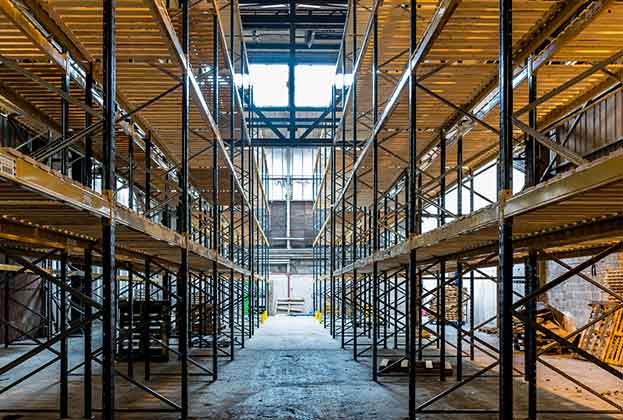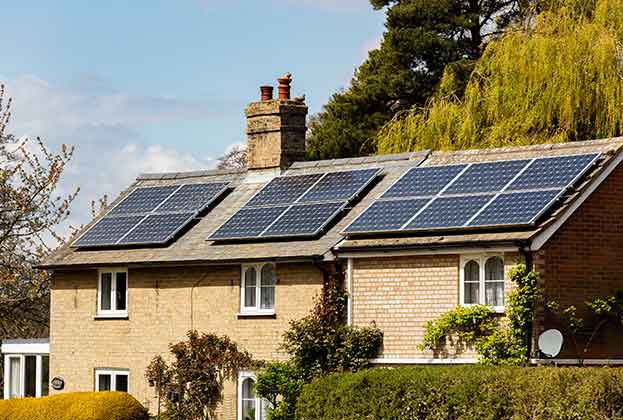Over a fifth of UK CO2 emissions are from residential stock, but it is also likely to be the toughest sector to decarbonise
The residential sector is responsible for over one-fifth of all UK CO2 emissions, and since 2014 decarbonisation rates have slowed. Emissions of CO2 have increased by 9% since 2014. In 2017, the government published an ambition to upgrade all homes where “cost-efficient, affordable and practical” to EPC C by 2035. But the scale of the challenge is considerable, with a third of homes built pre-war still carrying EPC ratings of E or below. To meet the 2035 target, the rate of retrofit needs to be seven times greater than current levels, and EPC improvements data suggests the total cost could be as much as £330 billion.
The problem will be harder to resolve than other sectors. Decarbonisation works are intrusive for residents, can impact the appearance of a home, and may not result in lower energy bills. There is also currently limited evidence of a residential green premium that could incentivise improvements. Consequently, a higher level of policy intervention, such as property-specific taxes, will likely be needed to move the market, particularly for owner-occupiers.
AMBITIONS AND CHALLENGES
- In 2017, the government published an ambition to upgrade all homes where “cost-efficient, affordable and practical” to EPC C by 2035 (EPC E by 2020 and EPC D 2025)
- To meet the 2035 target, the rate of energy-efficient renovation will need to increase by 7x according to the Department for Business, Energy and Industrial Strategy
- Information on EPCs estimates the cost of implementing all potential energy efficiency improvements is in the order of £330bn; previous grant schemes have been a drop in the ocean
PROBLEM #1
The payback on many energy improvements remains unattractive (especially the big-ticket items such as photovoltaics, solid floor and wall insulation).
The economics of getting the EPC level C:
PROBLEM #2
While the value of the asset is affected by its energy efficiency, the uplift in value for most homes won’t justify the expenditure.
Average £ per sq ft vs a band D home:
Other policy considerations
HERITAGE PROPERTY
Listed properties present a particular challenge as improvement works will often conflict with the need to protect their special architectural and historical merit. Clarity on the policy trade-off between heritage and energy efficiency is essential, including the nature of concessions and exemptions.
HEATING
While the International Energy Agency has already called for a ban on the sale of fossil fuel boilers by 2025, current government proposals are that they will only be banned on newly constructed homes from that date. A requirement for hydrogen ready boilers from 2035 looks more likely. Other alternatives such as heat pumps and biomass-fed district heating are likely to become increasingly common, subject to cost and production.
CARROTS & STICKS – THE ROLE OF TAXATION
Grant and green finance initiatives alone are unlikely to facilitate the step-change in investment in energy efficiency needed to meet government targets. More radically, discounts and surcharges on property-specific taxes such as stamp duty and council tax have the potential to increase the 'green premium' and 'brown discount' of housing, providing a greater incentive for owners to invest in energy efficiency improvements.
The challenge by tenure
AFFORDABLE HOUSING
- 5.08 million homes
- EPC ratings 2016–2020:
- Getting to zero carbon by 2050 is underpinned by regulatory requirement of the Decent Homes Standard
Savills Housing Sector Survey 2021
- 25% of providers do not have a planned timescale to upgrade stock to zero carbon
- 42% plan to complete works between 2031 and 2040
- A further 19% plan to complete works between 2041 and 2050
- 37% have not factored costs into their business plan
- Average expected costs of improvement stand at £20,600 per dwelling
- 17% of homes may be uneconomic to upgrade, a catalyst for redevelopment, stock sales and offsetting
PRIVATE RENTED SECTOR
- 5.57 million homes
- EPC ratings 2016–2020:
- In England and Wales private landlords already need to be at a minimum of EPC E unless costs exceed £3,500
- Proposals are to tighten that to EPC C and to increase the exemption cost to £10,000
- There are similar regulations in Scotland
- As the ambition to reduce emissions increases, so minimum standards will be increased and exemptions tightened
- 37% have not factored costs into their business plan
- These requirements will place an additional cost burden on private investors, putting particular pressure on mortgaged buy-to-let landlords. Institutions with purpose-built portfolios are much better placed to meet these obligations though currently represent less than 3% of the sector
OWNER-OCCUPIERS
- 18.93 million homes
- EPC ratings 2016–2020:
- Average energy consumption among owner-occupiers is 21% higher than private renters and 43% higher than those in the affordable housing sector (Source: BEIS)
MORTGAGED
- 8.70 million homes
- Favoured policy lever is to tackle energy efficiency through mortgage lending or re-mortgage
- That would involve lending targets for both energy efficiency improvements and the efficiency profile of a lender’s portfolio
- Were proposals to affect lending terms this could quickly change the economics of undertaking improvement works; particularly if interest rates rise
OUTRIGHT
- 10.23 million homes
- +1.55m in the past 10 years
- Dominated by older households in less energy-efficient homes
- Owners are conscious of heating prices, but the cost of improvements presents a major obstacle unless increased grants plug the gap
- Without a mortgage, the trigger point will often be on sale. Yet, on average, an outright owner has been in their home for 24 years.
Read the other articles within Spotlight: Real Estate and the Carbon Challenge below
.jpg)



